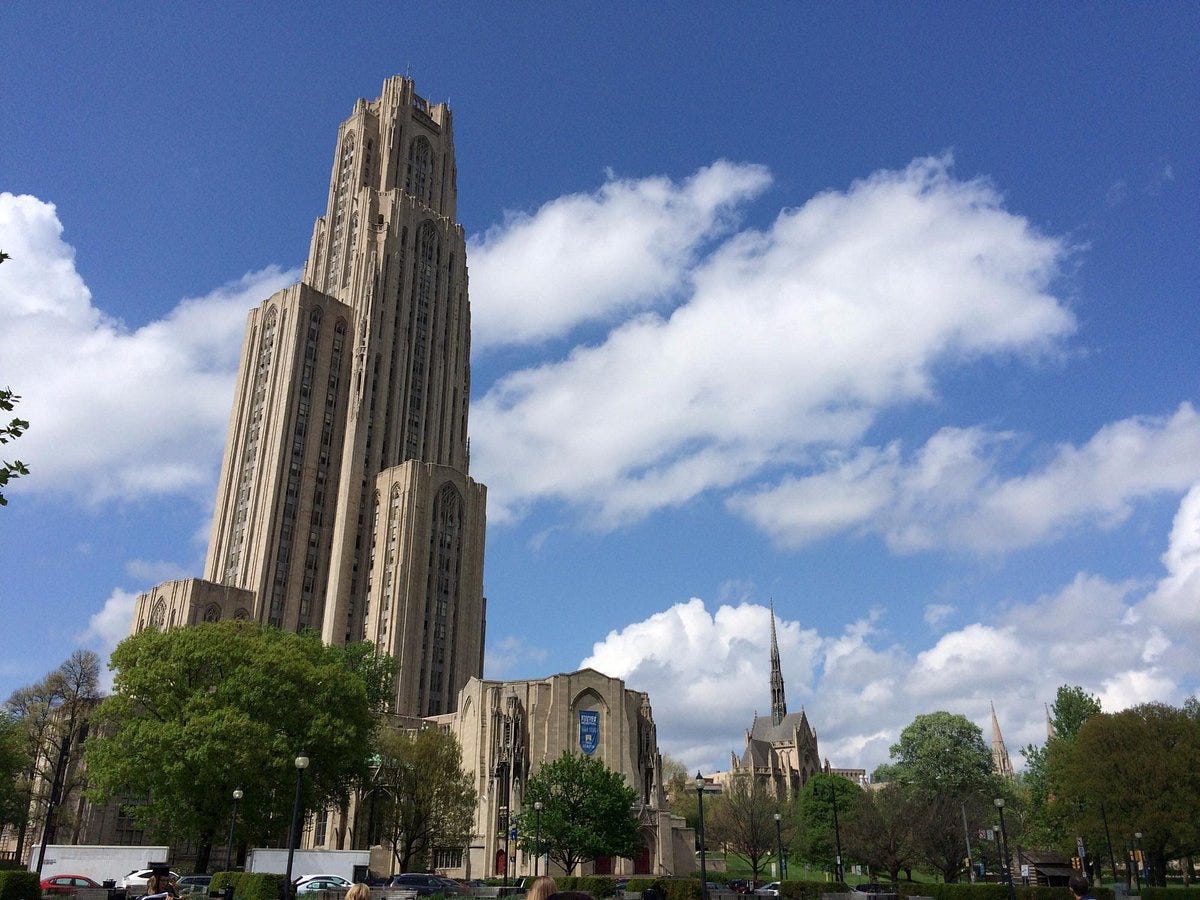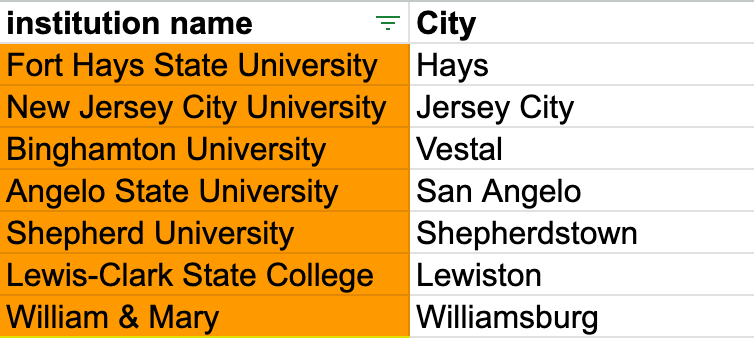How many public universities are named after cities?
State institutions sometimes get away with localism
The other day, I was walking across campus here at Indiana University. I passed one guy wearing a University of Chicago polo shirt. I then passed a woman wearing a sweatshirt for Manhattan University.
Somehow, the thought occurred to me that I was walking across a public institution named after a state, but I’d just seen two people in shirts for private institutions named after cities (or boroughs).
I started to think about more cities and what kinds of colleges were named after them. Here’s what came to mind:
New York University: private
Boston University: private
Boston College: private
Miami University (FL): private
Seattle University: private
Denver University: private
My mind flitted across the map, and the same thing kept coming back: they’re all private??
After some laborious consideration, a few contrary examples came to mind:
University of Louisville: public!
University of Houston: public!
University of Pittsburgh: public! Kinda! (Pennsylvania is weird)
That was as many as I could think of with the simple naming scheme “University of [City]”. But there are other examples, ones which use the word “State” but only name the city specifically, like Boise State or Portland State.
Anyway, I know an IPEDS question when I find one, and this felt like something I could answer more completely.
So I did!

A simple journey with IPEDS
My perpetual companion, IPEDS, made finding the answer to this question possible.
I created a custom data set (as can you) and used the EZ Groups function to assemble the possible list of institutions meeting my criteria.
As I said, I was focusing on public institutions. That’s easy to limit for. But I also wanted to limit it to four-year institutions. The reason for this is that it’s extremely common for community colleges, which are mostly public, to be named after their city. That’s kind of a different question though.
By limiting the results to four-year institutions, I had about 850 results. After looking at that list, though, I realized that I’d made a strategic error. There were a bunch of community colleges on the list. Why?
Because tons of community colleges offer four-year degrees! For example, Vincennes primarily offers two-year degrees and certificates. But you could also go there to get a bachelor’s degree in surveying management, among others.
Because some community colleges offer four-year degrees, they will show up as four-year institutions. So, I had to further limit my results to institutions which “primarily award four-year degrees.”
This gave me a list of 561 public colleges and universities which primarily award four-year degrees.
The Big Picture
In order to assess the urbanity of each institution’s naming choice, I just had to read this whole list.
My method was pretty simple. I’d included the name of the city where each institution was located in my data report. So all I really had to do was see whether the name of the school matched the name of the city.
If the name of the state was included anywhere in the name, I did not count it. This is the most common way for university systems to name their campuses. Think Cal-Berkeley or UI-Chicago or, even, Indiana University of Pennsylvania, which is named after the town of Indiana, PA. And as quirky as that naming convention is, the presence of the state disqualifies it for my purposes.
Although universities will often go by more than one name, I used the name they reported on IPEDS as my metric. For example, marketing materials may say Slippery Rock University is the name of the institution in Slippery Rock, PA. But the name it reports on IPEDS is Slippery Rock University of Pennsylvania, so out it goes.
I found that 457 of the 561 institutions under review definitely aren’t named after their host city. That’s nearly 82%. So, hey, like I imagined, it’s pretty uncommon.
But depending on how you define the question, your answer might be even more fractional. Let’s look at some caveats.
CUNYs
So, out of 86 possible city-named schools, 12 are members of the City University of New York system. These are public universities, all located in New York City. Here’s a list of them!
That second column is the state, the third is the urbanization level, and the last column is the city. Now, New York is interesting because, as far as mailing addresses go, not all parts of the city use “New York” as the city name. It’s not even necessarily the borough, as CUNY York’s mailing address is Jamaica, which is in Queens, which is in New York City.
But either way, we know they’re located in New York City. The question is whether they’re named after New York City.
The system is named The City University of New York, undeniably a city-named system of institutions. The acronym for that city system is part of each campus name. But since they’re all in New York, each campus is named for something else. There is no “New York College.”
Admittedly, there are some close ones. City College is, by implication, named after the city in which it’s located. York College is nearly there, but it could refer to an older York. The closest is “City Tech” whose full, Christian name is “City University of New York New York City College of Technology.”
I would at least give this system partial credit.
SUNYs
If we look upstate, there are other questions in New York.
The State University of New York system oversees all public universities in the state, aside from the CUNYs. Most of them have a similar naming pattern. Here’s a few examples:
Whether they use an acronym or not, these institutions list New York (the state) in their official name. Or at least most of them do.
As far as I can tell, these two are totally unique. It’s not the University of Buffalo, but at Buffalo.
The issue is that while this is their reported name, it’s not their legal name. They follow the same pattern as Cortland above, meaning “University at Buffalo” is short for “State University of New York at Buffalo.”
So, these probably count, but they’re a bit odd, so I put them in a muted shade of green. By contrast, there’s one SUNY to which I gave full credit:
This has the familiar “[City] University” naming pattern. Of course, Stony Brook is also, legally, “SUNY Stony Brook.” So, while I’m going to give it credit for its reported name, other analysts of this critical topic may come to a different conclusion.
The States
By far the largest group of city-named institutions are those with the “[City] State University” naming pattern. 54 of the institutions I highlighted fit this pattern.
I won’t show the whole list, but this is the gist of what I’m talking about:
Some of the schools in this category are well known. Many are not. Would you have guessed that Pittsburg State (no “h”) was in Kansas?
At most, I’d give this category half credit because while it doesn’t have the specific state in the name, it does include the word “state.” This allusion to the higher governmental rung takes away from the localism a bit for me. But you’ll have to decide whether these feel more like institutions named after cities or state institutions which happen to be located in cities.
The Edge Cases
I found seven more universities that I wasn’t quite sure what to do with:
All of these are partial or near matches. Binghamton University might be the least valid. It’s clearly not named after the town it’s located it, but Vestal is a suburb of Binghamton. So it represents the metropolitan area. With that in mind, you might give it credit. But it’s also a SUNY! So, its legal name is “SUNY Binghamton.” Do with that what you will.
The others are all missing part of their city name (or, like Fort Hays, adding extra). The funniest one to me is New Jersey City University. Now, its former name was “Jersey City State University,” clearly indicating it was initially named after the city. But tossing that errant “New” onto the front makes you ask whether it names the state, the city, or both.
Is it a “New” Jersey City University? Or a New Jersey “City” University, which could refer to any city? Or was this a compromise to avoid calling it New Jersey Jersey City University?
I also have one more I’m even less sure how to categorize.
Did you know that Mississippi State was located in the city of Mississippi State? The issue is that the city is named after the university and basically contains the campus. It’s kind of like Bay Lake, FL, a “city” which contains most of Disney World.
You’ll have to decide for yourself whether the “direction” of whether the school is named “after” the city matters or just whether they match.
The No-Doubters
With all that said, there are 20 institutions which fit my conception of the city-named public university unambiguously. All of these fit the naming pattern “University of [City]” or “[City] University” or “College of [City].” There were no examples of “[City] College” referring to a public, 4-year institution.
So, here’s the list:
Alabama, Ohio, and Maryland clearly punch above their weight in city-naming terms.
Perhaps the thing that sticks out is how surprised I am that some of these names are public institutions. I can see that College of Charleston (the only “college” on the list) is public… but it feels like it should be private.
This is similar to the phenomenon where state flagships, like Clemson or Rutgers, not named after their states are assumed to be private by people from outside those states. Perhaps there are just too many universities, such that we need clues like having the state name, or at least the word “state,” in the name for us to recognize them as public institution.
Admittedly, it only really matters that in-state students know whether an institution is public or not. Out-of-state students end up paying private school prices (or more) if they go to most out-of-state institutions.
So, of our 561 public, 4-year institutions, between 20 and 104 of them are “named after” cities, depending on the stringency of your definition.
If you’d like to examine the results for yourself and come to your own conclusions, feel free to check out my spreadsheet here.
-Matt










I’ve had this question pop on my head many times and your in depth analysis is beyond my wildest dreams
Can I ask why Auburn University is not included?